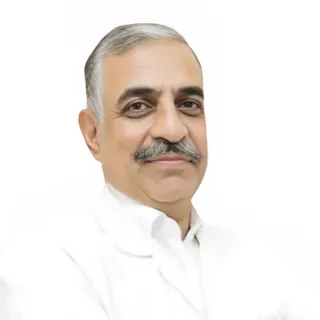Central vein interventional procedures involve minimally invasive techniques to diagnose and treat conditions affecting the central veins, such as stenosis or occlusion. Using advanced imaging technology, a catheter is inserted into the central vein, typically through the groin or arm, allowing for precise navigation within the vascular system. These interventions may include angioplasty to widen narrowed veins, stent placement to support vessel structure, or thrombolysis to dissolve blood clots. Central vein interventions aim to restore proper blood flow, alleviate symptoms, and prevent complications like deep vein thrombosis or venous insufficiency. They offer a less invasive alternative to traditional surgical approaches, promoting faster recovery.
Why Do You Need Central Vein Interventional?
Central vein interventional procedures are necessary for various reasons, primarily aimed at addressing issues within the central veins of the body. Here's why you might need central vein intervention
- Vascular Conditions: Conditions such as central vein stenosis (narrowing) or occlusion (blockage) can restrict blood flow in the central veins, leading to symptoms like swelling, pain, or skin changes.
- Symptom Relief: Central vein interventions can alleviate symptoms associated with impaired blood flow, such as swelling in the arms or legs, skin discoloration, or chronic pain, improving the overall quality of life.
- Prevention of Complications: Left untreated, central vein disorders can lead to complications like deep vein thrombosis (DVT), pulmonary embolism (PE), or venous insufficiency. Interventional procedures help mitigate these risks by restoring proper blood flow and reducing the likelihood of clot formation.
- Improved Vascular Function: By widening narrowed veins (angioplasty), providing structural support with stent placement, or dissolving blood clots (thrombolysis), central vein interventions aim to restore optimal vascular function, ensuring efficient circulation throughout the body.
- Alternative to Surgery: Central vein interventions offer a less invasive alternative to traditional surgical approaches, minimizing the risks associated with open surgery, reducing hospitalization time, and promoting faster recovery.
- Customized Treatment: Each central vein intervention is tailored to the individual's specific condition and anatomy, allowing for precise diagnosis and targeted treatment to optimize outcomes.
- Enhanced Imaging: Advanced imaging technologies like fluoroscopy, ultrasound, or intravascular ultrasound (IVUS) provide real-time visualization during procedures, enabling accurate catheter placement and effective treatment delivery.
Central vein intervention is essential for diagnosing and treating various vascular conditions, relieving symptoms, preventing complications, and restoring optimal vascular function, ultimately improving the patient's overall health and well-being.
Types of Central Vein Interventional
Central vein interventional procedures encompass a range of techniques aimed at diagnosing and treating conditions affecting the central veins of the body. Here are some common types of central vein intervention
- Angioplasty involves inserting a small balloon-tipped catheter into the narrowed or blocked central vein. Once in place, the balloon is inflated, widening the vein and restoring proper blood flow. Sometimes, a stent (a small mesh tube) may be placed to keep the vein open.
- Stent Placement: Stents support the structure of weakened or collapsed veins. They are inserted into the vein using a catheter and expanded to create a scaffold, preventing re-narrowing and maintaining blood flow.
- Thrombolysis: Thrombolysis dissolves blood clots within the central veins. Medications delivered directly to the clot through a catheter break down the clot, restoring blood flow. This procedure is often used in deep vein thrombosis (DVT) or central vein thrombosis cases.
- Venous Access Procedures: Central vein intervention may involve creating or maintaining access to the central veins for medical treatment. This can include placing central venous catheters or ports for administering medications, fluids, or blood products.
- Embolization: In cases of abnormal or dysfunctional veins, embolization may be performed to block off the problematic vein. This is achieved by injecting a special material, such as coils or glue, into the vein to stop blood flow and redirect it to healthier vessels.
- IVC Filter Placement: In certain situations where blood clots are at risk of traveling to the lungs, an inferior vena cava (IVC) filter may be inserted into the central vein to catch and prevent clots from reaching the lungs.
These interventions are tailored to each patient's specific needs, aiming to restore proper vascular function, alleviate symptoms, and prevent complications associated with central vein disorders
Know Your Treatment Cost
Get a cost estimate based on your condition and hospital preferences.
Factors Affecting the Cost of Central Vein Interventional with small paragraph and points
Several factors influence the cost of central vein interventional procedures, including
- Procedure Complexity: The complexity of the intervention, such as the number of veins involved, the severity of the condition, and the specific techniques required, can impact costs.
- Diagnostic Imaging: Advanced imaging technologies like fluoroscopy, ultrasound, or intravascular ultrasound (IVUS) during the procedure contributes to overall costs.
- Medical Equipment and Supplies: Costs associated with catheters, balloons, stents, medications, and other medical supplies used during the intervention contribute to the overall expense.
- Hospital Fees: Facility fees, including pre-procedure consultations, operating room use, recovery room stays, and post-procedure care, vary depending on the healthcare facility and geographic location.
- Physician Fees: The total cost also includes the professional fees of the interventional radiologist or vascular surgeon performing the procedure.
- Anesthesia: If general anesthesia or sedation is required, anesthesia fees will be factored into the overall cost.
- Additional Services: Additional services such as pre-procedure testing, follow-up appointments, and potential complications may increase costs.
The total cost of central vein interventional procedures depends on a combination of these factors, and patients should discuss potential expenses with their healthcare provider and insurance company beforehand.
How Patients are Selected for the Procedure?
Patients are selected for central vein interventional procedures based on careful evaluation and consideration of various factors by their healthcare providers. Here's how patients are typically selected for such procedures and the signs they consider
- Medical History: Healthcare providers review the patient's medical history, including any previous vascular procedures, coexisting medical conditions (hypertension, diabetes, or kidney disease), and medications.
- Symptoms: Symptoms suggestive of central vein disorders, such as swelling, pain, heaviness, or discolouration in the arms or legs, are carefully assessed. Symptoms may indicate issues like central vein stenosis, occlusion, or thrombosis.
- Diagnostic Tests: Imaging tests, such as ultrasound, CT scans, MRI, or venography, are performed to evaluate the anatomy and function of the central veins. These tests help identify specific abnormalities or blockages that may require intervention.
- Vascular Function: Tests to assess vascular function, such as measuring blood pressure in the arms and legs or assessing blood flow using Doppler ultrasound, provide valuable information about circulation and potential areas of concern.
- Risk Factors: Risk factors for central vein disorders, such as a history of blood clots, venous catheterization, or central venous access devices, are considered. Certain medical conditions or lifestyle factors may also increase the risk of vascular issues.
- Patient Goals and Preferences: Patient preferences, goals, and expectations regarding treatment outcomes, including symptom relief, improvement in quality of life, and avoidance of complications, are considered during the decision-making process.
Diagnostic Tests and Evaluations Performed to Determine the Need for Central Vein Interventional
To determine the need for central vein interventional procedures, healthcare providers utilize various diagnostic tests and evaluations to assess the central veins' anatomy, function, and pathology. Here's an overview of the diagnostic tests commonly performed:
- Ultrasound: Ultrasound imaging is a non-invasive test that uses high-frequency sound waves to create images of the blood vessels in the arms or legs. It can identify blockages, narrowing, or abnormalities in the central veins, such as stenosis or thrombosis.
- CT Venography: CT venography involves injecting a contrast dye into a vein followed by CT scanning to produce detailed images of the veins. It helps visualize the structure and integrity of the central veins and detect any abnormalities or blockages.
- MR Venography: Magnetic resonance venography (MRV) uses magnetic fields and radio waves to create detailed images of the veins. MRV provides excellent visualization of the central veins without exposing the patient to ionizing radiation.
- Venous Doppler Ultrasound: Doppler ultrasound evaluates blood flow in the veins by measuring the speed and direction of blood flow. It can detect blood clots (thrombosis) and assess the severity of venous insufficiency.
- Venography: Venography involves injecting a contrast dye into a vein and taking X-ray images to visualize the blood vessels. It provides detailed information about the anatomy and function of the central veins and helps identify blockages or abnormalities requiring intervention.
- Functional Testing: Functional tests, such as measuring blood pressure in the arms and legs or assessing blood flow using Doppler ultrasound, help evaluate vascular function and identify areas of impaired circulation.
Risks and Benefits Associated with Central Vein Interventional
Central vein interventional procedures offer both risks and benefits, which must be carefully weighed by healthcare providers and patients. Here's a discussion of the potential risks and benefits associated with these interventions
Benefits of Central Vein Interventional:
- Symptom Relief: Central vein interventions can alleviate symptoms associated with impaired blood flow, such as swelling, pain, heaviness, or discolouration in the arms or legs. These procedures improve quality of life and functional status by restoring proper blood flow.
- Prevention of Complications: Left untreated, central vein disorders can lead to serious complications such as deep vein thrombosis (DVT), pulmonary embolism (PE), or venous insufficiency. Central vein interventions help mitigate these risks by restoring blood flow and reducing the likelihood of clot formation or chronic venous insufficiency.
- Improved Vascular Function: Angioplasty, stent placement, thrombolysis, and other central vein interventions aim to restore optimal vascular function by widening narrowed veins, providing structural support, or dissolving blood clots. This helps ensure efficient circulation throughout the body and reduces the risk of further vascular complications.
- Less Invasive Alternative: Central vein interventions offer a less invasive alternative to traditional surgical approaches. They minimize the risks associated with open surgery, reduce hospitalization time, and promote faster recovery.
Risks of Central Vein Interventional:
- Bleeding: There is a risk of bleeding at the catheter insertion site, particularly if blood-thinning medications are used during the procedure. In some cases, bleeding may require additional interventions or blood transfusions.
- Infection: Infection at the catheter insertion site or within the bloodstream (sepsis) is a potential complication of central vein interventions. Strict sterile techniques and antibiotic prophylaxis are used to minimize this risk.
- Vascular Injury: There is a small risk of injury to the blood vessel during catheter manipulation, leading to vascular perforation, dissection, or pseudoaneurysm formation. This risk is minimized by experienced operators using advanced imaging techniques.
- Allergic Reactions: Contrast dye used during imaging tests may cause allergic reactions in some patients, ranging from mild skin rashes to severe anaphylaxis. Precautions are taken to identify and manage allergic reactions promptly.
- Thrombosis or Embolism: Central vein interventions may dislodge blood clots or cause new clot formation, leading to thrombosis (clotting) or embolism (clot traveling to other body parts). Anticoagulant medications may be prescribed to reduce this risk.
While central vein interventional procedures offer significant benefits in alleviating symptoms, preventing complications, and improving vascular function, they also entail potential risks that should be carefully considered and discussed with healthcare providers before proceeding. Personalized risk-benefit assessments and informed decision-making are essential to optimize treatment outcomes and minimize complications.
Recovery and Rehabilitation after Central Vein Interventional
Recovery and rehabilitation after central vein interventional procedures are crucial for optimizing outcomes and ensuring a smooth return to normal activities. Here's what patients can typically expect during the recovery process
- Immediate Post-Procedure Care: Patients are monitored closely in a recovery area for some time to ensure stability after the procedure. Vital signs are monitored, and the healthcare team addresses any immediate post-procedural discomfort or complications.
- Activity Restrictions: Following the procedure, patients may be advised to limit physical activity and avoid strenuous exertion for a certain period. The duration of activity restrictions varies depending on the specific intervention and individual patient factors.
- Pain Management: Patients may experience mild discomfort or soreness at the catheter insertion site or in the treated area. Over-the-counter pain relievers or prescription medications may be prescribed to manage pain as needed.
- Follow-up appointments: Patients typically have follow-up appointments with their healthcare provider to monitor progress, assess healing, and evaluate the effectiveness of the intervention. Additional imaging tests may be performed to ensure proper vascular function.
- Resumption of Normal Activities: Depending on the complexity of the procedure and individual recovery progress, patients can gradually resume normal activities, including work, exercise, and daily routines. It's essential to follow healthcare providers' guidance regarding activity levels and restrictions.
- Lifestyle Modifications: Patients may be advised to make certain lifestyle modifications to promote vascular health, such as maintaining a healthy diet, exercising regularly, quitting smoking, and managing underlying medical conditions like hypertension or diabetes.
- Long-Term Follow-Up: Regular long-term follow-up appointments may be recommended to monitor vascular health, assess for any recurrence of symptoms or complications, and adjust treatment plans as necessary.
What to Expect After a Central Vein Interventional?
After undergoing a central vein interventional procedure, patients can expect recovery and adjustment as their body heals and adjusts to the changes made during the intervention. Here's what patients can typically expect after a central vein interventional procedure
- Immediate Post-Procedure Period: Patients are typically monitored closely in a recovery area for some time following the procedure. Vital signs are monitored, and the healthcare team addresses any immediate post-procedural discomfort or complications.
- Discharge Instructions: Before leaving the healthcare facility, patients receive detailed discharge instructions from their healthcare provider. These instructions may include information about wound care, activity restrictions, pain management, and medication instructions.
- Pain and Discomfort: Patients may experience mild discomfort or soreness at the catheter insertion site or in the treated area. Over-the-counter pain relievers or prescription medications may be prescribed to manage pain as needed.
- Activity Restrictions: Following the procedure, patients are typically advised to limit physical activity and avoid strenuous exertion for a certain period. The duration of activity restrictions varies depending on the specific intervention and individual patient factors.
- Follow-up appointments: Patients are scheduled for follow-up appointments with their healthcare provider to monitor progress, assess healing, and evaluate the effectiveness of the intervention. Additional imaging tests may be performed to ensure proper vascular function.
- Gradual Return to Normal Activities: Depending on the complexity of the procedure and individual recovery progress, patients can gradually resume normal activities, including work, exercise, and daily routines. It's essential to follow healthcare providers' guidance regarding activity levels and restrictions.
- Long-Term Follow-Up: Regular long-term follow-up appointments may be recommended to monitor vascular health, assess for any recurrence of symptoms or complications, and adjust treatment plans as necessary.
How is Central Vein Interventional Performed?
Central vein interventional procedures are performed by trained interventional radiologists or vascular surgeons in a specialized procedure room equipped with advanced imaging technology. Here's an overview of how a typical central vein interventional procedure is performed
- Preparation: Before the procedure begins, the patient is positioned on the procedure table, and vital signs are monitored. The area where the catheter will be inserted (typically the groin or arm) is cleaned and sterilized, and a local anesthetic is administered to numb the skin.
- Catheter Insertion: Using fluoroscopy or ultrasound guidance, the interventionalist inserts a thin, flexible catheter into a vein in the groin or arm. The catheter is carefully navigated through the vascular system toward the target area in the central veins.
- Imaging and Navigation: Throughout the procedure, real-time imaging techniques such as fluoroscopy, ultrasound, or intravascular ultrasound (IVUS) visualize the catheter's position and guide its movement through the veins. This allows for precise navigation and placement of the catheter within the central veins.
- Diagnostic Evaluation: Once the catheter is positioned in the central veins, a contrast dye may be injected through the catheter to visualize the veins and identify any abnormalities or blockages. Additional imaging tests, such as CT venography or MR venography, may also be performed to further evaluate the anatomy and function of the central veins.
- Intervention: Various interventional techniques may be employed depending on the specific condition being treated. These may include angioplasty to widen narrowed veins, stent placement to support vessel structure, thrombolysis to dissolve blood clots, or embolization to block off abnormal veins.
- Post-Procedure Care: After the intervention, the catheter is removed, and pressure is applied to the insertion site to prevent bleeding. The patient is monitored in a recovery area to ensure stability before being discharged home.
Central vein interventional procedures involve a combination of advanced imaging techniques, precise catheter navigation, and targeted interventions to effectively diagnose and treat conditions affecting the central veins. Close collaboration between the healthcare team and the patient ensures a safe and successful procedure.
 17 December,2025
Read More
17 December,2025
Read More






 17 December,2025
Read More
17 December,2025
Read More
 16 December,2025
Read More
16 December,2025
Read More
 10 December,2025
Read More
10 December,2025
Read More
 09 December,2025
Read More
09 December,2025
Read More
 05 December,2025
Read More
05 December,2025
Read More
 04 December,2025
Read More
04 December,2025
Read More